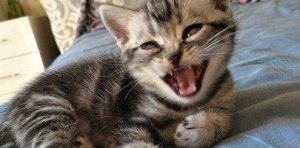Panleukopenia, also known as feline distemper or infectious enteritis, is a highly contagious and severe disease that can affect American Shorthair cats. Here’s a comprehensive guide on treating this condition:
Symptoms and Signs
The disease is characterized by a sudden onset of high fever, persistent vomiting, diarrhea, dehydration, circulatory problems, and a significant decrease in white blood cell count. The incubation period typically ranges from 2 to 9 days.
Kittens a few months old often develop acute symptoms, with body temperatures rising above 40°C, accompanied by vomiting. In some cases, kittens may pass away suddenly without showing prior symptoms. In cats older than six months, the disease usually takes a subacute form. They may first develop a fever around 40°C, which subsides to normal after 1 – 2 days but then spikes again after 3 – 4 days (biphasic fever pattern). Infected cats may appear lethargic, lose their appetite, vomit persistently (with vomit appearing yellow – green), have sticky secretions from the mouth, eyes, and nose, and suffer from thickened feces that may later become bloody. Severe dehydration and anemia are also common.
Treatment Approaches
1. Specific Therapy
Feline panleukopenia immune serum has shown promising results in clinical use. The recommended dosage is 2 ml per kilogram of body weight, administered via intramuscular injection every two days.
2. Supportive Therapy
Supportive treatments aim to alleviate symptoms and support the cat’s recovery. These include anti – vomiting, anti – inflammatory, antipyretic, hemostatic, sugar – supplementing, alkali – supplementing, and fluid – replacement therapies.
-
Anti – vomiting: Metoclopramide injection at 0.15 – 0.25 ml per kilogram of body weight, twice daily via intramuscular injection.
-
Antibiotics: Gentamicin at 10,000 units per kilogram of body weight or Kanamycin at 50,000 – 100,000 units per kilogram of body weight, twice daily via intramuscular injection.
-
Antipyretic: Bupleurum injection at 0.3 ml per kilogram of body weight, twice daily.
-
Fluid therapy: A mixture of 5 – 10 ml of 25% glucose, 5 ml of 5% sodium bicarbonate injection, and 30 – 50 ml of compound sodium chloride solution can be administered via intravenous injection.
-
Hemostatic: Vitamin K3 injection at 0.3 ml per kilogram of body weight, twice daily via intramuscular injection.
3. General Nursing Care
-
Comfortable Environment: Ensure your cat has a quiet and comfortable space to rest. Avoid disturbances to aid recovery.
-
Nutrition and Hydration: If your cat is not eating, your vet may recommend supplemental nutrition. Encourage water intake to prevent dehydration.
-
Regular Vet Check – ups: Follow – up visits are crucial to monitor your cat’s condition and adjust treatment as needed.
4. Preventive Measures
-
Vaccination: Preventive vaccination is key. Ensure your American Shorthair cat receives the panleukopenia vaccine as recommended by your vet.
-
Hygiene: Maintain good hygiene practices. Regularly clean and disinfect your cat’s living areas to minimize the risk of infection.
While the above methods can help treat panleukopenia in American Shorthair cats, prevention is always better than cure. Timely vaccination and proper care can significantly reduce the risk of this disease. If your cat shows any symptoms of panleukopenia, consult a veterinarian immediately for accurate diagnosis and treatment.

